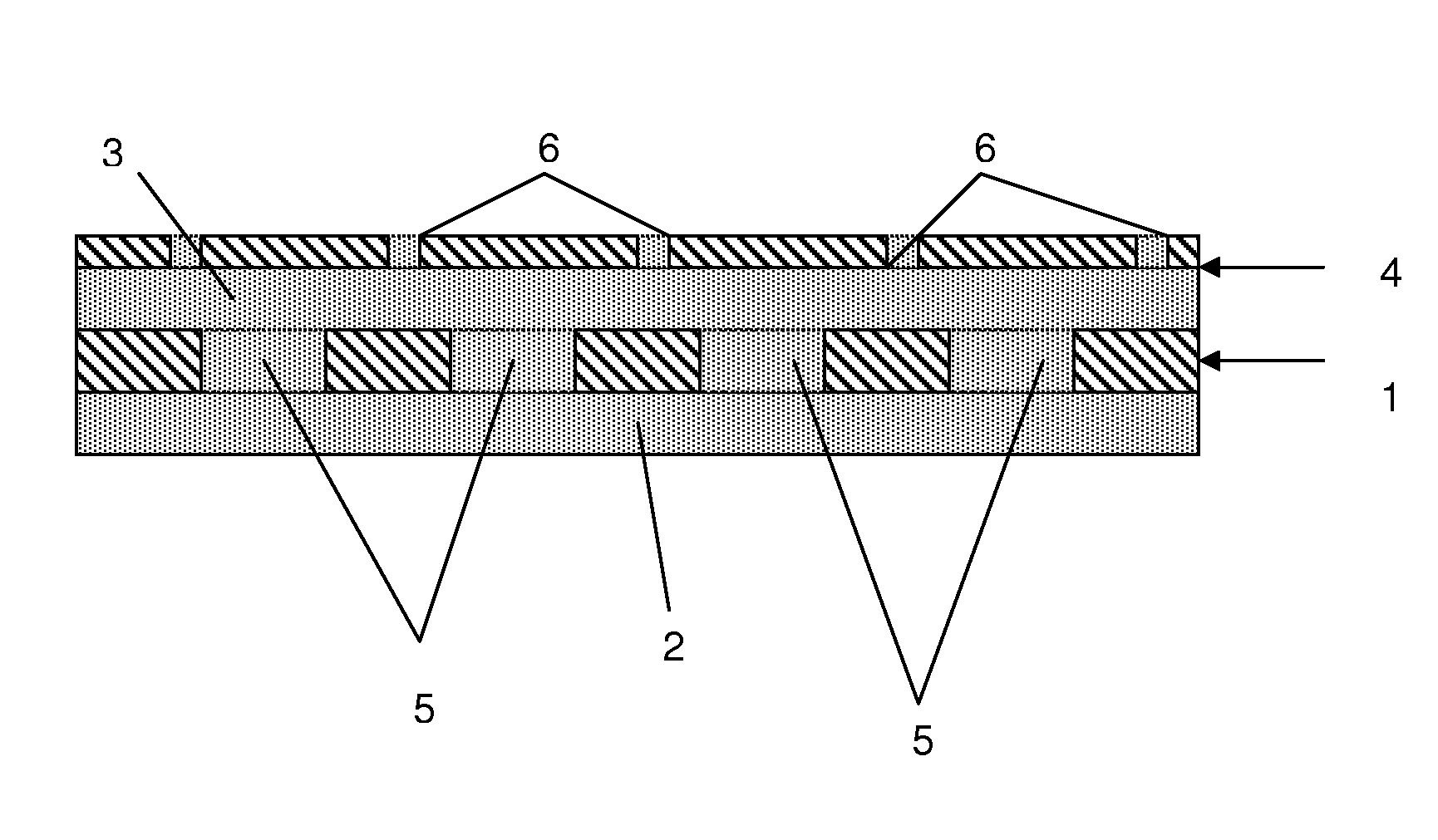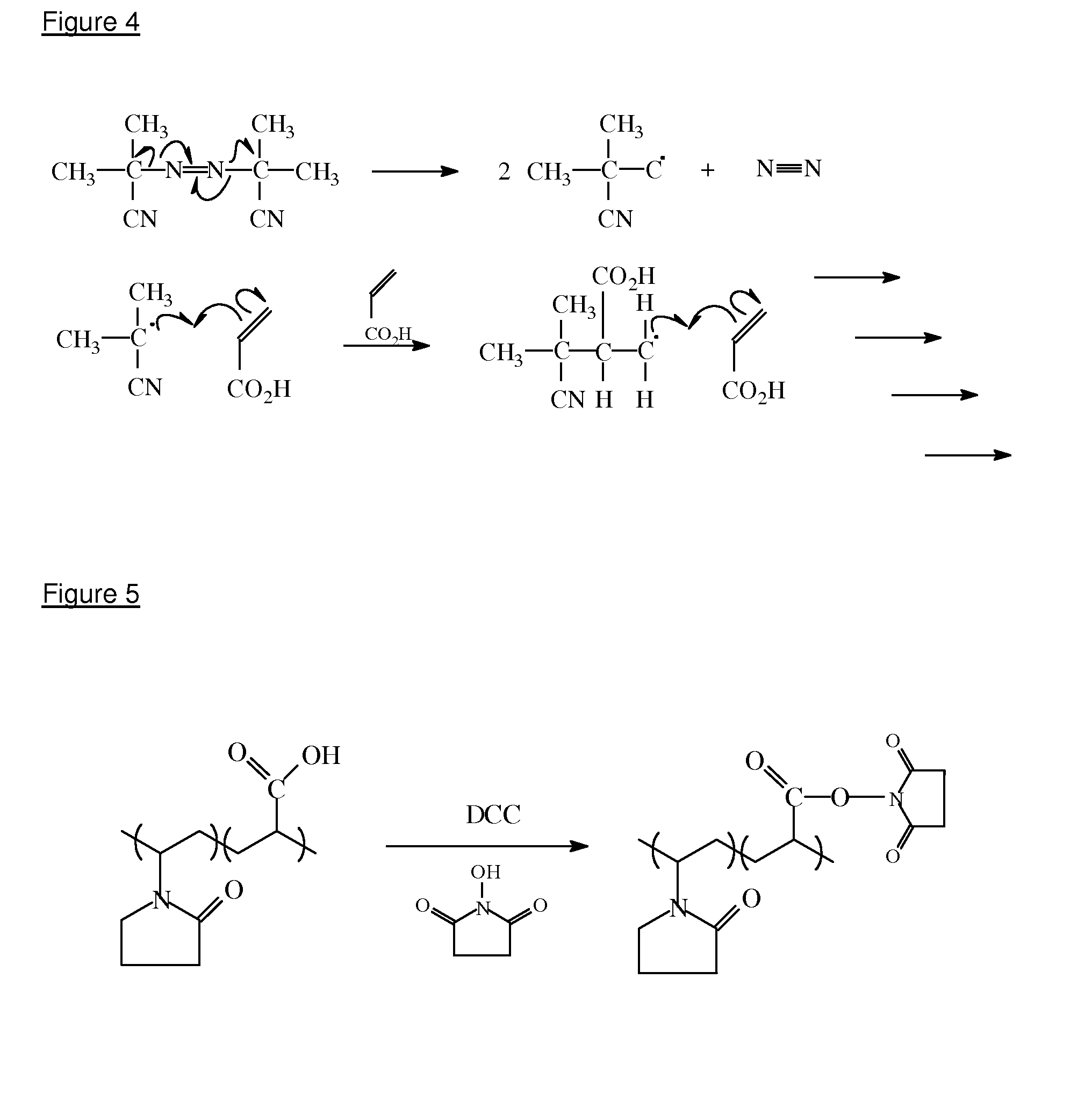Tissue-adhesive formulations
- Summary
- Abstract
- Description
- Claims
- Application Information
AI Technical Summary
Benefits of technology
Problems solved by technology
Method used
Image
Examples
example 1
Synthesis of poly(VP-AAc(NHS))
First Method
[0118]1.1 Polymerisation of acrylic acid and N-vinyl-2-pyrrolidone
[0119]The polymer is formed via the polymerisation of monomers such as N-vinyl-2-pyrrolidone and acrylic acid, as shown in FIG. 3.
[0120]A number of methods may be used to initiate the polymerisation, such as free radical, ionic (cationic or anionic), thermal, UV, redox etc. Free radical polymerisation is the preferred polymerisation method and AIBN is the preferred initiator. The AIBN decomposes into two radicals which can then attack the carbon-carbon double bond in the vinylic monomer (acrylic acid) as shown in FIG. 4.
[0121]This will continue until termination of chain growth, via combination, disproportionation etc.
[0122]The reaction solvent may be DMF, toluene, or any other suitable solvent with a boiling point greater than 100° C. Toluene is the currently preferred solvent.
[0123]A typical polymerisation method is as follows:
[0124]Solvent is charged to the reaction flask. ...
example 2
Synthesis of poly(VP-AAc(NHS))
Second Method
2.1 Polymerisation
[0130]400 ml of dried toluene is heated to 80±2° C. in a round bottomed flask using an oil bath or isomantle. Oxygen is removed from the solvent by bubbling oxygen-free nitrogen through the toluene for at least 30 minutes. 0.1 g (0.006 moles) of AIBN dissolved in 2 ml of toluene is added to the reaction flask using a syringe, immediately followed by 45.02 g (0.406 moles) of 1-vinyl-2-pyrrolidone and 7.02 g (0.092 moles) of acrylic acid. The reaction is left under nitrogen at 80±2° C. for 17 hours; the polymer is insoluble in toluene and forms a white precipitate as the reaction proceeds. After 17 hours, a further 0.1 g (0.006 moles) of AIBN is added and the reaction is kept at 80±2° C. for one further hour to polymerise any remaining monomer. The polymer is isolated by pouring into 2000 ml of rapidly stirred 1:1 hexane:diethyl ether and subsequent filtration using a 10-16 μm filter. The polymer is dissolved in 200 ml of DM...
example 3
Synthesis of poly(VP-AAc(NHS))
Third Method
3.1 Polymerisation
[0134]600 ml of dried toluene is heated to 80±2° C. in a round bottomed flask using an oil bath or isomantle. Oxygen is removed from the solvent by bubbling oxygen-free nitrogen through the toluene for at least 30 minutes. 0.144 g (8.8×10−4 moles) of AIBN dissolved in 3 ml of toluene is added to the reaction flask using a needle and syringe, immediately followed by 64.88 g (0.576 moles) of 1-vinyl-2-pyrrolidone and 10.11 g (0.140 moles) of acrylic acid. The reaction is left under nitrogen at 80±2° C. for 17-19 hours; the polymer is insoluble in toluene and forms a white precipitate as the reaction proceeds. After 18±1 hours, the polymer is isolated by pouring into 2880 ml of rapidly stirred 1:1 hexane:diethyl ether and subsequent filtration under reduced pressure using a 10-16 μm filter. The polymer is purified further by three successive washes with 600 ml of diethyl ether, each wash being followed by filtration under redu...
PUM
| Property | Measurement | Unit |
|---|---|---|
| Thickness | aaaaa | aaaaa |
| Thickness | aaaaa | aaaaa |
| Thickness | aaaaa | aaaaa |
Abstract
Description
Claims
Application Information
 Login to View More
Login to View More - R&D
- Intellectual Property
- Life Sciences
- Materials
- Tech Scout
- Unparalleled Data Quality
- Higher Quality Content
- 60% Fewer Hallucinations
Browse by: Latest US Patents, China's latest patents, Technical Efficacy Thesaurus, Application Domain, Technology Topic, Popular Technical Reports.
© 2025 PatSnap. All rights reserved.Legal|Privacy policy|Modern Slavery Act Transparency Statement|Sitemap|About US| Contact US: help@patsnap.com



